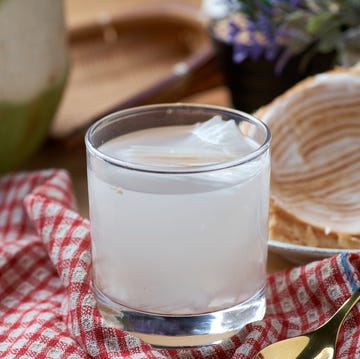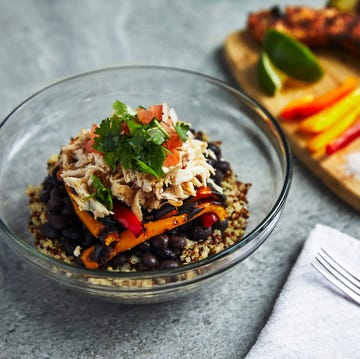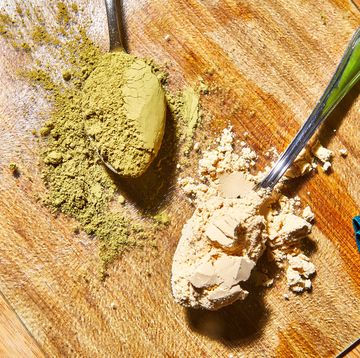The research is in and eating high-protein foods can help adults maintain their muscle mass through life. In fact, according to a 2019 systematic review and meta-analysis study published in Advances in Nutrition, dairy protein, in particular, can help improve muscle mass in middle-aged and older adults.
One great food option to reap this benefit? Cottage cheese. This grocery staple—which can go sweet or savory, low-fat or high-fat—is a tasty choice to use as a basis for meals or snacks.
Like other dairy products, including yogurt, many bands promote cottage cheese with new flavors, improved textures, and nutritional upgrades, such as probiotics.
More From Runner's World

Read on to learn about the benefits of cottage cheese, and why it’s no longer a boring “diet food” of days past, but rather a nutritious, tasty, and versatile staple to help boost your health and performance.
What are the health and nutrition benefits of cottage cheese?
Cottage cheese contains a range of important nutrients. One serving—1 cup—of 2-percent fat cottage cheese contains:
- 180 calories
- 24 g of protein
- 5 g fat
- 3 g saturated fat
- 9.5 g of carbs
- 0 g of dietary fiber
- 706 mg sodium
- 227 mg calcium
- 264 mg potassium
With roughly 12 grams of protein in a half-cup serving, cottage cheese is clearly a protein powerhouse. For comparison, the same serving of plain Greek yogurt contains about 10 grams of protein. That makes it a great option to maintain and build lean body mass. In fact, cottage cheese makes an excellent postworkout food, as research shows that 9 grams of milk-based protein can be enough to stimulate muscle-building after exercise.
The protein in cottage cheese is mainly casein protein, which is slower to digest than whey protein, and, in turn, may do a better job at promoting satiety. A study in the journal Appetite found that when matched for calories and protein, cottage cheese is just as satiating as eggs, making it a great breakfast option to keep you feeling full longer.
Since the consumption of casein protein results in a slower trickle of amino acids into your system, science suggests that eating casein-containing items like cottage cheese as a nighttime snack could help preserve and build muscle during several hours of sleep.
In addition to supporting muscle mass, a study in Journal of Nutrition in Gerontology and Geriatrics supports the benefits of cottage cheese for bone health.
When it comes to maintaining bone health, don’t just focus on cottage cheese’s calcium content—it also packs about a third of your daily need for phosphorous in a one-cup serving. Phosphorus may be one of the lesser-known minerals, but that doesn’t make it any less essential. It is vital for helping the body maintain stronger bones and teeth and is a part of ATP, the key energy source your body turns to when running.
Not to be overlooked is the solid amount of selenium you get in each spoonful. Greater intakes of this nutrient may reduce the risk of suffering from depression and type 2 diabetes.
Another nutrient in cottage cheese worth noting is riboflavin, a B vitamin that helps your body metabolize carbohydrates, proteins, and fats into the energy you use for all your daily activities. As a bonus, the lumpy cheese is a stellar source of vitamin B12, a nutrient that helps keep the body’s red blood cells and nervous system healthy and also aids in the production of DNA, the genetic material in all our cells.
It’s worth noting that cottage cheese can be much higher in sodium than yogurt—a half-cup serving may have up to 400 milligrams. The daily sodium recommendation is 2,300 mg or less. Salt is added to help preserve cottage cheese because it’s high in moisture. This makes it a food of concern for those whose blood pressure is sensitive to sodium. On the flip side, this extra hit of sodium can be part of your nutrition recovery following a sweaty run.
Keep in mind that not all cottage cheese is made with vitamin D-fortified milk, so it may not help you take in enough of this essential vitamin. Make sure to read your food labels, and aim to get your vitamin D elsewhere if necessary.
Finally, cottage cheese is low in carbohydrates, which is why it’s often considered a staple for low-carb diets. A majority of the carbs in plain cottage cheese come from a naturally occurring milk sugar called lactose.
But, like yogurt, flavored cottage cheese typically contains added sugars and is higher in calories than plain varieties. Look for options with 5 grams of added sugar or less in a serving, and ones flavored with real fruit. Some brands use low-calorie sweeteners like stevia for sweetness instead. Or, you can opt for no-sugar-added plain cottage cheese and top with fresh berries or chopped fruit for natural sweetness.
How is cottage cheese different than other cheeses?
Cottage cheese is considered a fresh cheese since it’s not aged or ripened like Parmesan, gouda, and cheddar.
To make it, an acid compound or acid-producing culture is added to milk, which begins the process of separating the liquid whey protein from the milk solids, or curds. It is these curds that create cottage cheese’s lumpy appearance, and now many brands have both small and large curd varieties.
What are the different options for cottage cheese products?
As with yogurt, you can find a lot of options out there for cottage cheese: fat-free, 1-percent, 2-percent, and 4-percent. Although it’s important to not go overboard on saturated fat, some research suggests that full-fat dairy products might not raise the risk for certain conditions like type 2 diabetes or heart disease after all.
Plus, full-fat dairy will keep you feeling fuller for longer, and athletes who are in the midst of high-volume training could benefit from these extra calories to help meet overall energy needs. Ultimately, the choice on how high or low to go with the amount of fat in your cottage cheese is a personal one based on nutrition goals that should be discussed with a sports dietitian or doctor.
Remember, too, that some cottage cheese brands add an extra probiotic boost via active cultures, which is similar to what you see in yogurt. This can feed the good bacteria in your gut and play a role in improving digestive and immune health.
Keep an eye out, as well, for versions made using organic milk or sourced from grass-fed cows, which may offer a nutritional advantage in terms of higher amounts of heart-healthy omega-3 fats and less saturated fat.
To date, options for lactose-free cottage cheese on the market are limited but you may find an option on store shelves, like Lactaid.
What’s the best way to serve cottage cheese?
The most popular way to eat cottage cheese is as if it were yogurt, dumped in a bowl and topped with fruit and maybe a handful of nuts or granola. But these mild, protein-packed curds can be used in so many different ways.
Blend into smoothies and dips, stir into oatmeal for a shot of creamy protein, make it the base of a savory bowl of roasted veggies, or spread on rye crackers and top with sliced avocado or a sprinkle of paprika and chives.
Cottage cheese also makes a good substitute for ricotta cheese, sour cream, and even mayonnaise in recipes like lasagne, creamy dressings, and tuna or egg salad.
Get creative with your substitutes: You can blend it with foods like bananas and maple syrup for a quick pudding that packs a nutritional punch. Or, use cottage cheese as a substitute for the eggs and milk in pancakes.












